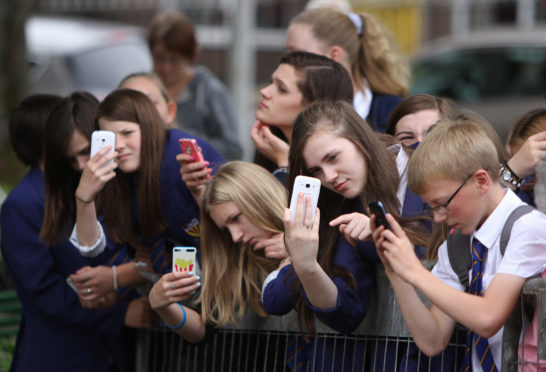Madam, – I would imagine it was music to the ears of most teachers to hear a Westminster education minister talk the other day about banning pupils from taking mobile phones into school.
Though Nick Gibb’s educational remit is south of the border, his sentiments would undoubtedly have chimed with Scottish teachers in the hope that Scottish education secretary John Swinney might also advocate a similar ban in Scotland.
Of course, in this dynamic technological age, it is such a pity that it has come to this as the mobile phone is not all bad. In fact, if used responsibly and with the permission of the classroom teacher, phones can be an invaluable learning aid as they enable pupils’ access to dictionaries, thesauruses, encyclopedias and calculators – all at the instant swipe of an app or search engine.
However, as in most cases, it is the irresponsible few who spoil it for the rest.
Increasingly, recalcitrant pupils with phones cause disruption – in some cases orchestrated with texting back and forth to encourage friends to play up in different classes.
With this in mind, the real challenge facing any education chief brave enough to take on the mobile phone louts is to empower schools and teachers with the sanctions necessary to implement such a ban.
Knowing the separation issues kids have when they are phone-less, and that it is generally easier to snatch a rump steak from the jaws of a Rottweiler than to take a phone from a teenager, tough and uncompromising action will be necessary for any such ban to stand any chance of success.
Currently, many teachers turn a blind eye to kids who text during class as they know from experience the torrent of foul-mouthed abuse, and in some cases physical assault, they may be subjected to.
Who can blame teachers for taking the safe and easy way out?
Currently, there’s no guarantee senior management will support them, and if a child’s parents kick up a big enough fuss the child will be given “special permission” to have their phone.
I’m afraid I get the feeling that the genie is out of the bottle when it comes to mobile phones in schools, and authority backing down to pupils and parents has an all too familiar ring about it.
However, I’d love to be proved wrong and for Nick Gibb or John Swinney, or preferably both, to have the guts to take the argument to unsupportive parents and defiant pupils and show them that their number is finally up.
Jamie Buchan,
Grove Road,
Dundee.
New unit could help save jobs
Madam, – In the wake of the McGill company collapse (City ‘in crisis’ as 374 jobs axed at McGill, Courier, February 2) and the Michelin departure.Could administrators, company owners and their lenders not approach a specifically created government unit for emergency tide-over funding to keep a company alive?
After all, redundant workers will cost the government money anyway in dole, housing and family benefits, etc.
The unit could have a list of projects which could be started using the newly unemployed.
It would be redolent of the 1920s-30s public works projects undertaken with the minimum red tape.
Health boards and local authorities are bound to have projects awaiting national government funding.
The unit just needs imaginative leadership with a “can be done” attitude.
John Smith,
Broughty Ferry,
Dundee.
Flogging a dead high street horse
Madam, – In the week M&S moves to Glenrothes, The Postings is sold for £1 and Santander announces the closure of its Kirkcaldy branch, do we celebrate that the percentage of independent retailers just went up or mourn the demise of the town centre?
A fortnight ago Councillor Neil Crooks hosted a town centre regeneration meeting, the main materials of which were a copy of the 2015 Framework and a presentation by Kirkcaldy 4 All.
No mention was made – although it was on the agenda – of parking initiatives, much to the disappointment of several members present.
My motion to the area committee requesting action was dismissed with such passion I assumed a placemaking plan was formulated, that the 2021 start date was a mistake, and Fife Council would ride in on the white horse and save us.
Sadly I have been deceived once again, along with Kirkcaldy’s voters.
My hope is a three month trial of free parking and de-pedestrianisation of the high street would give us an indication whether we can breathe life back in to the town centre, or we’re flogging a dead horse.
The council wants to plough ahead with road removal at the seafront with the bizarre hope this will encourage people to flock to the high street.
I contend that action on the high street would be the way to start.
Cllr Richard Watt,
Kirkcaldy East,
Scottish Conservative and Unionist Party.
Fire raises home truth for town
Madam, – The residents of Aberfeldy suggesting the shortage of retained firefighters in the town led to the severity of the fire on Friday night should first of all look in the mirror (Firefighter shortage is blamed for town centre blaze damage, Courier, February 4).
The Fire and Rescue Service relies on local people to crew the fire engine. Retained firefighters need to be able to get to the station within about five minutes and be able to respond to an alert whenever they are at home or nearby in the town.
Preferably they should also work close by and, if not self-employed, be released by their employer at the drop of a hat. Parents and others at home during the day are also welcomed.
Thus, those complaining may themselves be able to apply, or no doubt, will know someone they could encourage to. The answer lies with the community.
David Churchill,
2 Kirktonhill Road,
Kirriemuir.
Pipe down, Dame Vivienne
Madam, – Dame Vivienne Westwood has accused chemicals tycoon Jim Ratcliffe of wanting to destroy the environment by fracking.
Wind turbines have already achieved that and escalated energy bills. The Advertising Standard Authority censored Friends of the Earth (FoE) over an anti-fracking leaflet.
FoE were unable to substantiate their strident claims that fracking caused health problems.
FoE were warned never to repeat these or similar allegations or face legal proceedings.
They remain uncharacteristically silent.
Dame Vivienne should do the same.
Clark Cross,
138 Springfield Road ,
Linlithgow.
How will the SNP vote?
Madam, – It’s increasingly clear there won’t be a second EU referendum plus, while Article 50 may be delayed, it won’t be revoked.
So it’s Theresa May’s possibly slightly amended deal or no deal that’s the most likely binary choice for MPs.
Nicola Sturgeon opposes Theresa May’s compromise deal, while insisting no deal is the very worst outcome for Scotland. So how are her 35 SNP MPs going to vote in the Commons?
Alongside Jacob Rees-Mogg’s ardent Brexiteers or for Theresa May’s compromise?
Both are politically untenable to the SNP.
Martin Redfern,
Woodcroft Road,
Edinburgh.










